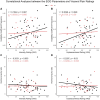Sex differences in the reactivity of gastric myoelectrical activity and heart rate variability as putative psychophysiological markers in human pain research
- PMID: 39726827
- PMCID: PMC11670328
- DOI: 10.3389/fnins.2024.1502752
Sex differences in the reactivity of gastric myoelectrical activity and heart rate variability as putative psychophysiological markers in human pain research
Abstract
Background: This study explored the potential of electrogastrography (EGG) and heart rate variability (HRV) as psychophysiological markers in experimental pain research related to the gut-brain axis. We investigated responses to the experience of pain from the visceral (rectal distension) and somatic (cutaneous heat) pain modalities, with a focus on elucidating sex differences in EGG and HRV responses.
Methods: In a sample of healthy volunteers (29 males, 43 females), EGG and ECG data were collected during a baseline and a pain phase. Data were analyzed for changes in gastric myoelectrical activity and cardiac autonomic regulation, with special attention to sex-specific patterns and correlations with perceptual responses to visceral and somatic pain stimuli, assessed by visual analogue scale ratings.
Results: Acute pain induced significant instability in EGG slow-wave frequency and amplitude, increased tachygastria, and decreased normogastric spectral power, without evidence of sex differences. HRV analyses revealed increases in SDNN, RMSSD, and pNN50 during pain, indicating sympathovagal regulation changes. While there were no significant sex differences in EGG responses, only female participants exhibited significant correlations between visceral pain unpleasantness and EGG alterations. HRV measures, particularly time-domain parameters, showed sex differences, independent of pain-induced autonomic reactivity.
Conclusion: The experience of pain in the lower abdominal region may induce impaired gastric motility. EGG and HRV are sensitive to acute pain and offer insight into pain mechanisms along the gut-brain axis. While EGG responses were consistent across sexes, HRV revealed sex-specific differences, suggesting that autonomic regulation and gastric motility may be modulated differently by pain and psychosocial factors. Further research in patients with chronic visceral pain is warranted.
Keywords: autonomic nervous system; electrogastrography; gut-brain axis; heart rate variability; psychophysiology; sex differences; stress; visceral pain.
Copyright © 2024 Draganova, Hartanto, Pawlik, Aulenkamp and Elsenbruch.
Conflict of interest statement
The authors declare that the research was conducted in the absence of any commercial or financial relationships that could be construed as a potential conflict of interest. The author(s) declared that they were an editorial board member of Frontiers, at the time of submission. This had no impact on the peer review process and the final decision.
Figures





Similar articles
-
Association of heart rate variability, blood pressure variability, and baroreflex sensitivity with gastric motility at rest and during cold pressor test.Gastroenterol Hepatol Bed Bench. 2021 Spring;14(2):132-140. Gastroenterol Hepatol Bed Bench. 2021. PMID: 33968340 Free PMC article.
-
Effects of water ingestion on autonomic activity and gastric motility in patients with celiac disease.J Physiol Pharmacol. 2023 Apr;74(2). doi: 10.26402/jpp.2023.2.06. Epub 2023 Jul 10. J Physiol Pharmacol. 2023. PMID: 37453094
-
Best Parameters of Heart Rate Variability for Assessing Autonomic Responses to Brief Rectal Distention in Patients with Irritable Bowel Syndrome.Sensors (Basel). 2023 Sep 28;23(19):8128. doi: 10.3390/s23198128. Sensors (Basel). 2023. PMID: 37836962 Free PMC article.
-
Autonomic dysfunction in posttraumatic stress disorder indexed by heart rate variability: a meta-analysis.Psychol Med. 2020 Sep;50(12):1937-1948. doi: 10.1017/S003329172000207X. Epub 2020 Aug 28. Psychol Med. 2020. PMID: 32854795 Free PMC article. Review.
-
Heart Rate Variability and Pain: A Systematic Review.Brain Sci. 2022 Jan 24;12(2):153. doi: 10.3390/brainsci12020153. Brain Sci. 2022. PMID: 35203917 Free PMC article. Review.
References
-
- Benson S., Siebert C., Koenen L. R., Engler H., Kleine-Borgmann J., Bingel U., et al. . (2019). Cortisol affects pain sensitivity and pain-related emotional learning in experimental visceral but not somatic pain: a randomized controlled study in healthy men and women. Pain 160, 1719–1728. doi: 10.1097/j.pain.0000000000001579, PMID: - DOI - PubMed
-
- Bu Y., Kurniawan J. F., Prince J., Nguyen A. K. L., Ho B., Sit N. L. J., et al. . (2022). A flexible adhesive surface electrode array capable of cervical electroneurography during a sequential autonomic stress challenge. Sci. Rep. 12:19467. doi: 10.1038/s41598-022-21817-w, PMID: - DOI - PMC - PubMed
LinkOut - more resources
Full Text Sources

